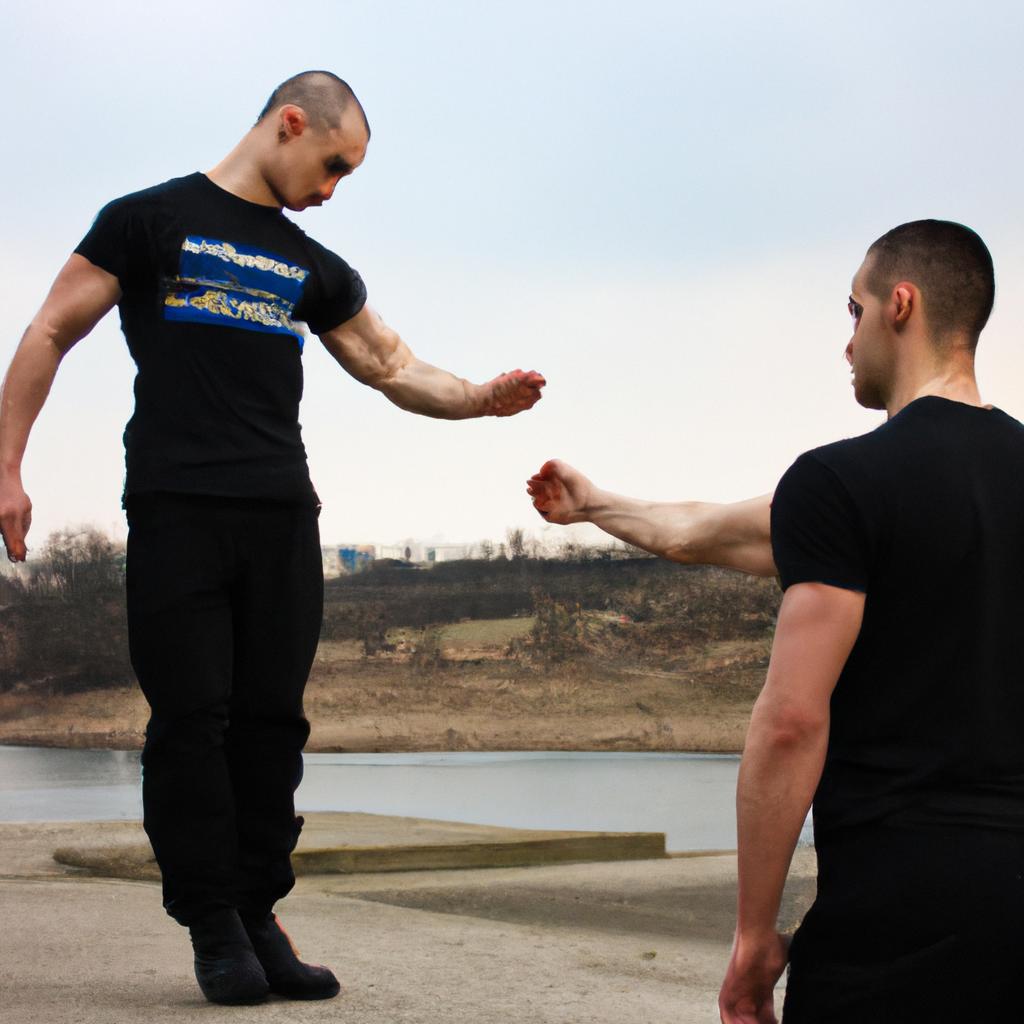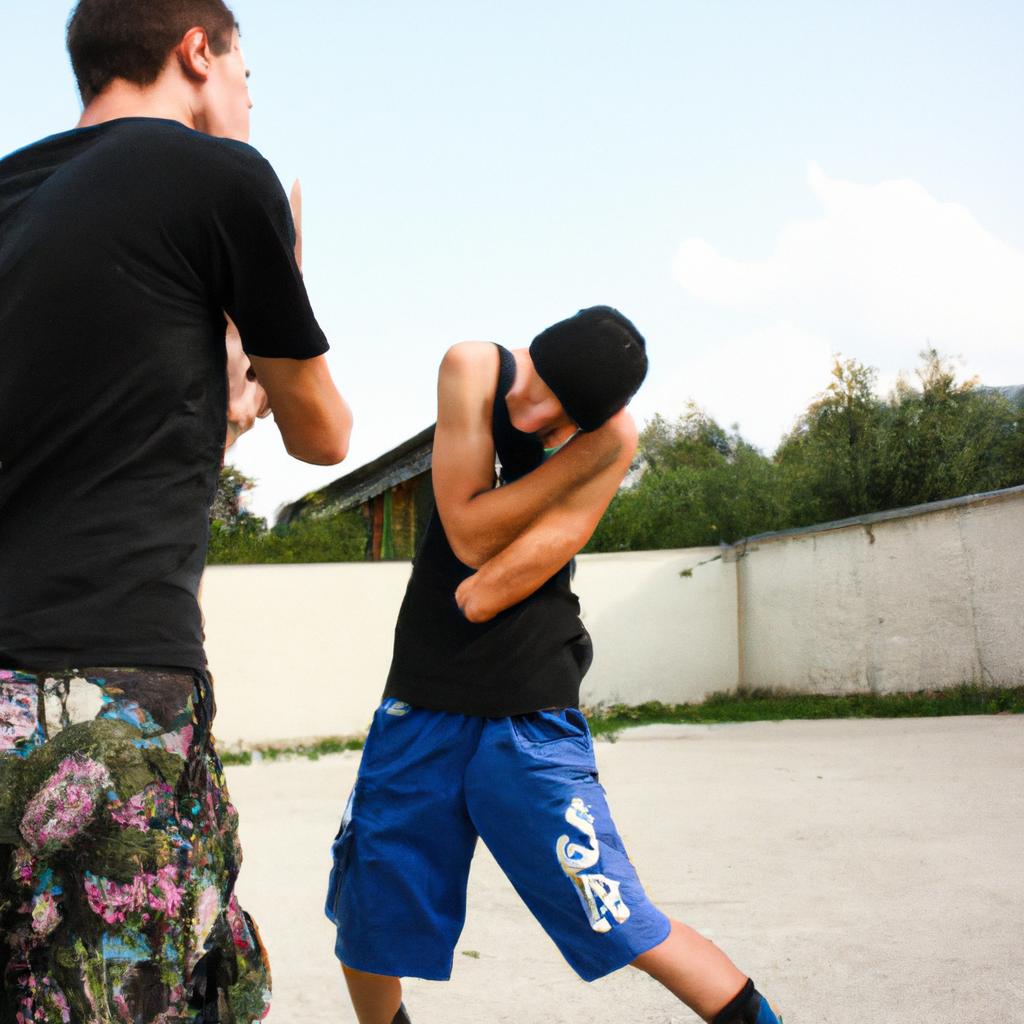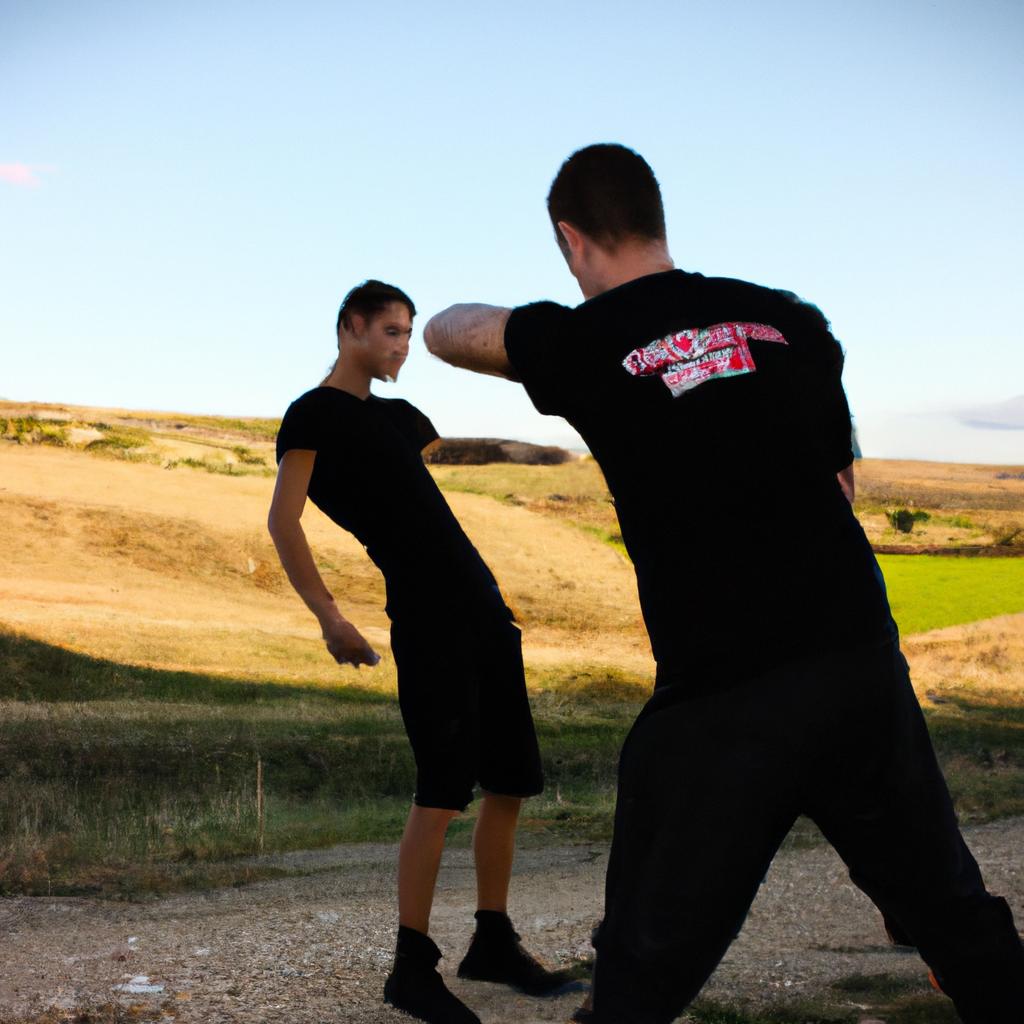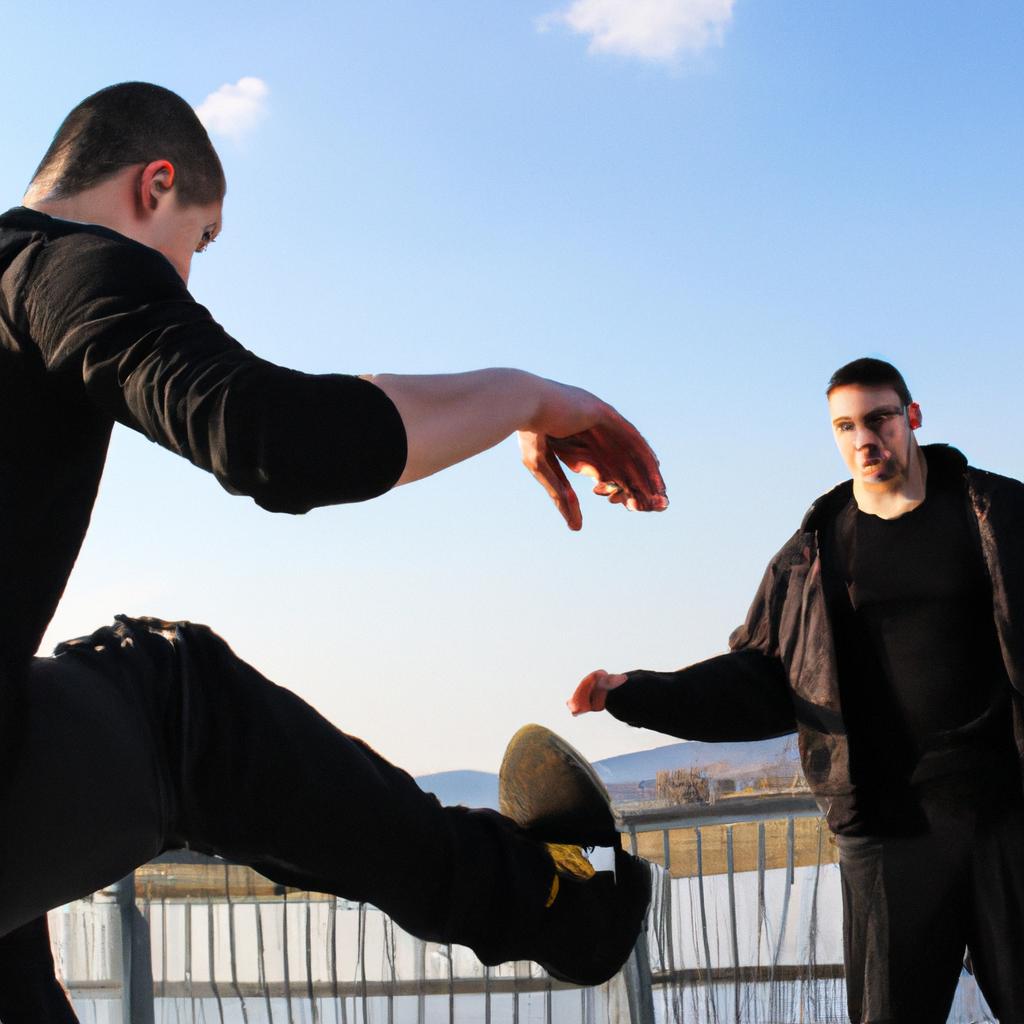Mixed Martial Arts (MMA) has gained significant popularity in recent years, captivating audiences with its high-intensity combat and diverse range of martial arts techniques. Within the realm of MMA, Krav Maga stands out as a particularly intriguing discipline due to its unique blend of history and philosophy. By examining the historical context and philosophical underpinnings of Krav Maga, we can gain a deeper understanding of this martial art form’s development and purpose.
Consider the case study of John, an amateur fighter who decided to pursue training in Krav Maga after witnessing its effectiveness firsthand. Despite having experience in other forms of martial arts, John found that Krav Maga offered him a more practical approach to self-defense. Intrigued by this newfound perspective, he delved into the origins and principles behind Krav Maga, discovering a rich tapestry woven from various influences ranging from street fighting techniques to military tactics.
To fully comprehend the significance of Krav Maga within the broader landscape of MMA, it is crucial to explore its historical roots. Developed in the 1930s by Imi Lichtenfeld, a renowned boxer and wrestler, Krav Maga was initially designed for Jewish communities facing anti-Semitic violence during pre-World War II times. Imi Lichtenfeld drew upon his own experiences as a street fighter and combined them with elements of boxing, wrestling, judo, and other martial arts to create an efficient and practical self-defense system.
As the threat of World War II loomed, Imi Lichtenfeld’s Krav Maga began to evolve further. He was recruited by the Israeli military to develop a combat system suitable for their soldiers. This led to the inclusion of techniques from various military disciplines such as hand-to-hand combat, knife fighting, and firearms training. The focus shifted towards quick and decisive strikes aimed at neutralizing threats efficiently in real-life confrontations.
The philosophy behind Krav Maga is rooted in the concept of simplicity and effectiveness. Its primary goal is to equip individuals with practical self-defense skills that can be applied in any situation or environment. Unlike traditional martial arts forms that emphasize strict adherence to specific techniques or styles, Krav Maga encourages adaptability and improvisation based on the immediate circumstances.
In John’s case study, he found that Krav Maga provided him with a more realistic approach to self-defense compared to his previous training in other martial arts forms. The emphasis on instinctive movements and utilizing natural body mechanics made it easier for John to apply Krav Maga techniques effectively under stress or pressure.
Furthermore, Krav Maga’s integration into MMA demonstrates its effectiveness as a well-rounded discipline within this competitive sport. Many MMA fighters incorporate Krav Maga techniques into their training regimen due to its focus on practicality and real-world application. The ability to seamlessly transition between striking, grappling, and defense makes practitioners of Krav Maga versatile competitors in the cage.
Overall, understanding the historical context and philosophical principles behind Krav Maga provides valuable insights into its significance within the realm of MMA. Its development from street fighting origins to its incorporation into military training highlights its effectiveness as a practical self-defense system. As MMA continues to evolve, disciplines like Krav Maga will continue to play a vital role in shaping the sport’s landscape.
The Origins of Krav Maga
Imagine a young Jewish man named Imi Lichtenfeld growing up in Bratislava, Slovakia during the turbulent years leading up to World War II. Witnessing numerous anti-Semitic attacks against his community, he became determined to develop a self-defense system that would enable individuals to protect themselves effectively in real-life confrontations. This desire for practicality and efficiency laid the foundation for what would later become known as Krav Maga.
To truly understand the origins of Krav Maga, it is essential to explore its historical context. In the aftermath of World War II, with the establishment of Israel as a nation-state, tensions escalated between Israelis and neighboring countries. It was within this hostile environment that Imi Lichtenfeld began refining his martial art, incorporating elements from various disciplines such as boxing, wrestling, judo, and street fighting techniques. His goal was not only to equip Israeli soldiers with effective combat skills but also to provide ordinary citizens with means of self-defense amidst ongoing conflict.
In recognizing the significance of Krav Maga’s development within this specific historical backdrop, several key aspects come into focus:
- Resilience: When faced with adversity, communities often seek ways to empower themselves and safeguard their well-being.
- Adaptability: Just as societies evolve over time, so do martial arts systems; they adapt according to changing circumstances and needs.
- Community cohesion: Practices like Krav Maga can foster unity among individuals who share similar experiences or face common threats.
- Preservation of cultural identity: By developing an indigenous martial art like Krav Maga, Israelis sought not only protection but also reaffirmation of their national heritage.
| Aspects | Significance |
|---|---|
| Resilience | Empowers individuals during challenging times |
| Adaptability | Allows for evolution based on changing circumstances |
| Community cohesion | Fosters unity among practitioners |
| Preservation of cultural identity | Reinforces national heritage and resilience |
Understanding the historical context behind Krav Maga’s origins provides valuable insights into its development as a martial art. As we delve further into the evolution of mixed martial arts (MMA), we will see how Krav Maga, with its emphasis on practicality and real-life application, influenced subsequent approaches to combat sports.
Moving forward, it is important to examine how MMA has embraced various fighting styles, including Krav Maga, in order to create a dynamic and ever-evolving sport that continues to captivate audiences worldwide.
The Evolution of MMA
The Origins of Krav Maga explored the historical roots and development of this martial art form. As we move forward in our exploration, it is essential to understand the broader context in which Krav Maga exists. In this section, we will delve into the history and philosophy within the realm of mixed martial arts (MMA) to gain a comprehensive understanding of how Krav Maga fits into this landscape.
To illustrate the significance of MMA’s evolution, let us consider a hypothetical scenario involving two fighters from different disciplines: one trained exclusively in traditional martial arts and the other in various combat sports such as boxing, wrestling, and Brazilian Jiu-Jitsu. When these two individuals step into an MMA cage, they bring with them their distinct training backgrounds and philosophies. This clash of styles not only showcases their individual skills but also highlights the transformative nature of MMA itself.
In examining the context surrounding MMA, several key factors come to light:
- Integration of Multiple Disciplines: One distinguishing feature of MMA lies in its ability to incorporate techniques from diverse martial arts disciplines. This integration allows for a more versatile approach that combines striking, grappling, ground fighting, and submissions.
- Emphasis on Practicality: Unlike some traditional martial arts forms that prioritize aesthetics or spiritual aspects, MMA places practicality at its core. The focus is on developing effective techniques that can be applied efficiently in real-world scenarios.
- Evolutionary Nature: MMA continues to evolve rapidly due to ongoing experimentation by practitioners worldwide. Fighters continually refine their skill sets by adopting successful strategies from various martial arts disciplines while discarding less effective ones.
- Testing Ground for Techniques: Through regular competitions and sparring sessions, MMA offers a platform for testing the effectiveness of different techniques under realistic conditions. This constant evaluation cultivates adaptability among fighters.
Table: Key Factors Shaping Modern Mixed Martial Arts
| Integration of Multiple Disciplines | Emphasis on Practicality | Evolutionary Nature | Testing Ground for Techniques |
|---|---|---|---|
| Allows versatility in combat | Focuses on real-world | Continual refinement of techniques | Tests effectiveness under realistic conditions |
Understanding the history and philosophy within MMA provides us with valuable insights into how Krav Maga has evolved.
Transitioning to the next section, it becomes evident that the influence of traditional martial arts plays a vital role in shaping both MMA and Krav Maga. By examining this influence, we can gain further appreciation for the evolution and unique characteristics of these disciplines.
The Influence of Traditional Martial Arts
The Influence of Traditional Martial Arts in MMA
As mixed martial arts (MMA) continued to gain popularity and evolve, it became evident that traditional martial arts played a significant role in shaping the sport. One example of this influence can be seen in the incorporation of Krav Maga techniques into MMA training. Krav Maga, known for its practical self-defense applications, has made an impact on the fighting style and philosophy embraced by many MMA practitioners.
To better understand the context of Krav Maga’s integration into MMA, it is important to examine some key factors:
-
Adaptability: One reason why Krav Maga gained traction in the world of MMA is its adaptability to real-life scenarios. Unlike other traditional martial arts that focus solely on technique and form, Krav Maga emphasizes quick decision-making under pressure. This ability to react swiftly and effectively translates well into the fast-paced nature of MMA fights.
-
Efficiency: Another aspect that caught the attention of MMA fighters was the efficiency of Krav Maga techniques. In a sport where every movement counts, simplicity and effectiveness are highly valued. The emphasis on utilizing natural body mechanics and targeting vulnerable areas aligns with the goal of quickly incapacitating opponents during a fight.
-
Street Fighting Origins: Krav Maga originated as a system designed for street fighting and self-defense purposes. Its practicality appealed to fighters who wanted to incorporate realistic combat strategies into their training regimen. By integrating elements from Krav Maga, such as situational awareness and preemptive strikes, MMA athletes could enhance their overall skill set both inside and outside of competition.
-
Mindset Shift: Beyond physical techniques, incorporating aspects of Krav Maga also brought about a mindset shift within the MMA community. Traditional martial arts often emphasize discipline, respect, and honor; however, with Krav Maga’s pragmatic approach to self-defense, there was a shift towards a more combative mindset that prioritized survival and protecting oneself at all costs.
| Krav Maga in MMA: Influences and Benefits | |
|---|---|
| 1 | Adaptability to real-life scenarios |
| 2 | Efficiency of techniques |
| 3 | Street fighting origins |
| 4 | Mindset shift towards practical self-defense |
In conclusion, the integration of traditional martial arts, such as Krav Maga, has had a profound impact on the evolution of MMA. The adaptability, efficiency, street-fighting origins, and mindset shift associated with Krav Maga have influenced fighters’ training methodologies and overall approach to combat. As we delve further into understanding the principles of Krav Maga, it becomes apparent how its incorporation into MMA has shaped not only the physicality but also the philosophy behind this dynamic sport.
Moving forward into our exploration of “The Principles of Krav Maga,” we will uncover the fundamental tenets that guide practitioners in their pursuit of effective self-defense strategies.
The Principles of Krav Maga
In the realm of mixed martial arts (MMA), it is crucial to understand the historical and philosophical context in which various disciplines have evolved. One such discipline that has gained prominence in recent years is Krav Maga, a self-defense system developed for the Israeli military. By examining the influence of traditional martial arts on Krav Maga, we can gain valuable insights into its origins and unique characteristics.
To illustrate this point, let us consider a hypothetical scenario where an individual with a background in traditional karate decides to explore Krav Maga as an additional form of training. This person brings their knowledge of striking techniques, footwork, and discipline from karate into the practice of Krav Maga. Through this integration, they discover how certain principles and movements from traditional martial arts can be adapted effectively for real-world combat situations.
When comparing the two systems side by side, several key aspects emerge that highlight the influence of traditional martial arts on Krav Maga:
- Philosophical Foundations: Both disciplines emphasize personal growth, mental resilience, and disciplined training.
- Striking Techniques: Elements such as punches, kicks, elbows, and knee strikes are present in both traditional martial arts and Krav Maga.
- Defensive Tactics: Concepts like parrying, blocking, evading attacks, and countering them play significant roles in both systems.
- Footwork: The importance of proper stance and movement patterns is emphasized across both traditions.
By incorporating these elements from traditional martial arts while also developing its own distinct approach to self-defense training, Krav Maga demonstrates how historical practices can shape modern combative systems. As we delve deeper into understanding the philosophy behind MMA in our subsequent section, it becomes evident that acknowledging these influences enriches our appreciation for this dynamic sport.
- The blending of different fighting styles ignites a sense of excitement and curiosity among practitioners.
- The practicality and effectiveness of Krav Maga techniques evoke feelings of empowerment and confidence.
- The shared principles between traditional martial arts and Krav Maga foster a sense of unity within the MMA community.
- Recognizing the historical context behind Krav Maga highlights its evolution as a relevant self-defense system.
| Traditional Martial Arts | Krav Maga |
|---|---|
| Emphasizes form and tradition | Focuses on real-world scenarios |
| Incorporates spiritual aspects | Prioritizes efficiency |
| Often practiced in dojos or studios | Trains in various environments |
| Competitions structured around specific rules | Training emphasizes adaptability |
Transitioning into our next section, it is important to explore the philosophy behind MMA, which encompasses not only the influences from traditional martial arts but also the unique characteristics that have emerged through its development. By delving into these philosophical underpinnings, we can gain a comprehensive understanding of how MMA has become an art form celebrated by athletes worldwide.
The Philosophy Behind MMA
Transition from Previous Section:
Having explored the fundamental principles of Krav Maga, we now delve into the philosophy behind Mixed Martial Arts (MMA). By understanding the historical and philosophical context in which MMA operates, we can gain a deeper appreciation for its evolution. This section will examine how various philosophies have influenced MMA’s development, paving the way for disciplines such as Krav Maga to find their place within this dynamic combat sport.
The Philosophy Behind MMA
To grasp the philosophy behind MMA, let us consider an example scenario: two fighters step into the octagon, each with their unique set of skills and techniques. One fighter is well-versed in Brazilian Jiu-Jitsu while the other excels in Muay Thai striking. As they engage in battle, one might assume that it is merely a clash between different fighting styles. However, beneath the surface lies something more profound – a blending of martial arts philosophies.
Within MMA, practitioners aim to combine various techniques and strategies from multiple disciplines effectively. This approach stems from several philosophical ideas:
- Adaptability: With no strict rules on which techniques are permissible, fighters must adapt to whatever situation arises during a bout.
- Efficiency: The emphasis is placed on using techniques that are proven to be effective rather than relying solely on tradition or aesthetics.
- Innovation: Fighters continually seek new methods and approaches to gain an advantage over their opponents.
- Respect for All Styles: Instead of promoting superiority among different martial arts systems, MMA celebrates diversity and encourages cross-training.
This fusion of philosophies creates an environment where traditional martial arts evolve alongside modern fighting methodologies. It paves the way for disciplines like Krav Maga to bring their own unique perspective and contribution to the world of MMA.
| Philosophy | Characteristics |
|---|---|
| Adaptability | – Ability to adjust quickly based on opponent’s actions. |
| Efficiency | – Focus on techniques that yield the highest success rate.- Elimination of unnecessary movements or flashy maneuvers. |
| Innovation | – Constant exploration of new strategies and tactics to gain an edge. |
| Respect for All Styles | – Embrace diversity in martial arts and promote mutual respect among practitioners regardless of their specific styles. |
In conclusion, MMA’s philosophy is not limited to any one style but rather embraces a dynamic approach that encourages adaptability, efficiency, innovation, and respect for all styles. This mindset allows fighters to draw upon various disciplines’ strengths while continuously evolving their own skill set. With this understanding, we can now explore how Krav Maga has found its place within the realm of MMA competition.
Transition into Subsequent Section:
Understanding the underlying philosophy behind MMA helps us appreciate how different disciplines contribute to its development. Now let us examine the role of Krav Maga in enhancing the effectiveness and versatility of fighters within this ever-evolving sport.
The Role of Krav Maga in MMA
In the previous section, we explored the underlying philosophy of mixed martial arts (MMA) and its emphasis on personal growth, discipline, and respect. Building upon this foundation, we now turn our attention to understanding the role of Krav Maga within the realm of MMA.
To illustrate the significance of Krav Maga in MMA, let us consider a hypothetical scenario. Imagine an amateur fighter who has trained extensively in various martial arts disciplines but lacks practical self-defense skills. In a crucial moment during a fight, their opponent unexpectedly launches an aggressive attack with swift strikes and grappling techniques. Without adequate knowledge of self-defense strategies like those found in Krav Maga, the amateur fighter may find themselves at a significant disadvantage.
Krav Maga is renowned for its pragmatic approach to combat situations and its effectiveness in real-world scenarios. Within MMA competitions, fighters often integrate elements from Krav Maga into their training regimen due to its focus on rapid response and efficient defense tactics. This integration enhances their ability to adapt quickly to unpredictable situations inside the octagon.
Understanding the importance of Krav Maga in MMA involves examining key principles that shape both philosophies:
- Simplicity: Both Krav Maga and MMA value simplicity in technique execution. They emphasize minimizing unnecessary movements while maximizing efficiency.
- Adaptability: The dynamic nature of both Krav Maga and MMA demands fighters be adaptable in different contexts or situations they encounter.
- Mental resilience: The philosophies encourage mental fortitude by instilling discipline, determination, and perseverance.
- Practicality: Both disciplines prioritize practical applicability over tradition or aesthetics; functionality takes precedence over form.
By recognizing these shared values between Krav Maga and MMA, practitioners can harness the strengths of each philosophy to enhance their fighting abilities effectively.
| Principle | Description |
|---|---|
| Simplicity | Emphasizes minimalistic movements for efficient technique execution. |
| Adaptability | Encourages fighters to adjust their strategies based on the ever-changing dynamics of a fight. |
| Mental Resilience | Instills discipline, determination, and perseverance to overcome challenges inside and outside the octagon. |
| Practicality | Prioritizes functional techniques that can be readily applied in real-world combat situations over traditional or aesthetic elements. |
Incorporating Krav Maga into MMA training not only enhances fighters’ self-defense skills but also cultivates mental resilience and adaptability needed to succeed in high-stakes competitions. By embracing the principles shared by these two disciplines, practitioners are better equipped to face different scenarios within and beyond the confines of an MMA bout.
Through this exploration of Krav Maga’s role in MMA, we have gained insights into how combining practical self-defense strategies with martial arts philosophies can enhance fighters’ overall capabilities. This integration serves as a testament to the constantly evolving nature of mixed martial arts, where diverse ideologies merge to create powerful tools for personal growth and success within the sport.




